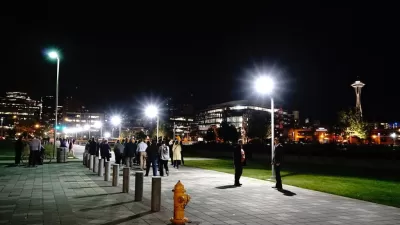Millenials really are migrating to cities in large numbers- but older age groups are merely leaving less rapidly than in the past.
I just discovered an interesting new website, Net Migration Patterns for US. This site contains migration data by age group for every county in the nation, and for every decade between the 1950s and the 2000s. The issue I was most interested was: are millenials really returning to walkable urban cores? And are baby boomers doing the same? My answers: yes and (sort of) no.
I focused on the counties containing five of the six most transit-friendly urban cores in the U.S.: Philadelphia, Washington, D.C. and San Francisco (all of which comprise their own counties), Manhattan, and Suffolk County, Mass. (which is dominated by the city of Boston).* By contrast, I was less interested in counties that contained a mix of urban places and suburban sprawl (such as Buffalo's Erie County or Chicago's Cook).
In all five cities, I saw the same pattern: net migration was positive for twentysomethings- that is, more people moved in than out. For age groups over 35 (and in some cities, over 30), net migration was generally negative- that is, more people moved out than in. However, even for older age groups, net outmigration was lower than in prior decades.
For example, in Manhattan, the net migration of 20-24 year olds into Manhattan was huge during the 2000s: 108 per 100 people. By contrast, in the disastrous 1970s, net migration of this group was still positive, but much less so: only 33 per 100. By contrast, older baby boomers (60-64 year olds) actually moved out more than they moved in: outmigrants exceeded inmigrants by 7 percent during the 2000s, down from 17 percent during the 1970s. (I note that this pattern was not unique to 60-64 year olds; the pattern among other over-35 age groups was roughly similar). In other words, older people still left Manhattan- but in smaller numbers than in past decades.
Other cities experienced similar patterns. For example:
*In San Francisco, net migration of 20-24 year olds was 101 per 100 (up from 42 in the 1970s). Net outmigration of 60-64 year olds was only 5 per 100 (down from 12 in the 1970s).
*In Philadelphia, net inmigration of 20-24 year olds was 33 per 100 in the 2000s; by contrast, outmigration exceeded inmigration in the 1970s, even among this age group. 60-64 year olds left more often than they moved in- but again, by a much narrower margin than in the past (4 per 100 in the 2000s, 15 per 100 in the 1970s).
*In Washington, DC, net inmigration of 20-24 year olds was 119 per 100 in the 2000s, as opposed to only 6 per 100 in the 1970s. Outmigration among 60-64 year olds was 8 per 100, as opposed to 18 in the 1970s.
*In mostly-urban Suffolk County (i.e. Boston) net migration of 20-24 year olds was 150 per 100, perhaps because of the city's colleges. But even in Boston, there was a big difference between the 2000s and the 1970s, when net inmigration among this group was only 51 per 100. 60-64 year olds moved out at a rate of 5 per 100 in the 2000s, down from 17 per 100 per 2000.
In sum, compared to the 1970s:
*cities are doing a better job at appealing to their base of young adults. In all five cities, more twentysomethings moved in than moved out; moreover, inmigration was substantially higher in the past decade than in the 1970s.
*cities still aren't attracting baby boomers in large numbers (at least not numbers large enough to offset outmigrants)- but they are doing a better job of doing so than they did a few decades ago. Although outmigrants exceeded inmovers in all five cities discussed above, they did so by a narrower margin in the 2000s than in the 1970s. Based on my reading of the charts discussed above, this also seems to be true for other over-35 age groups.
The story of urban revitalization in the popular press consists of multiple stories: a story of millenials rediscovering cities and a story of empty-nesters moving back. The first story is quite consistent with statistical reality, the second story somewhat less so.
*Chicago is also as transit-oriented as the abovementioned cities; however, Cook County is about evenly split between Chicago and its suburbs, and thus not comparable to the other cities discussed.

Planetizen Federal Action Tracker
A weekly monitor of how Trump’s orders and actions are impacting planners and planning in America.

Maui's Vacation Rental Debate Turns Ugly
Verbal attacks, misinformation campaigns and fistfights plague a high-stakes debate to convert thousands of vacation rentals into long-term housing.

San Francisco Suspends Traffic Calming Amidst Record Deaths
Citing “a challenging fiscal landscape,” the city will cease the program on the heels of 42 traffic deaths, including 24 pedestrians.

Amtrak Rolls Out New Orleans to Alabama “Mardi Gras” Train
The new service will operate morning and evening departures between Mobile and New Orleans.

The Subversive Car-Free Guide to Trump's Great American Road Trip
Car-free ways to access Chicagoland’s best tourist attractions.

San Antonio and Austin are Fusing Into one Massive Megaregion
The region spanning the two central Texas cities is growing fast, posing challenges for local infrastructure and water supplies.
Urban Design for Planners 1: Software Tools
This six-course series explores essential urban design concepts using open source software and equips planners with the tools they need to participate fully in the urban design process.
Planning for Universal Design
Learn the tools for implementing Universal Design in planning regulations.
Heyer Gruel & Associates PA
JM Goldson LLC
Custer County Colorado
City of Camden Redevelopment Agency
City of Astoria
Transportation Research & Education Center (TREC) at Portland State University
Jefferson Parish Government
Camden Redevelopment Agency
City of Claremont





























